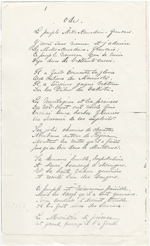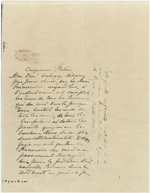Common menu bar links
Institutional links
ARCHIVED - Our Voices, Our Stories:
First Nations, Métis and Inuit Stories
Archived Content
This archived Web page remains online for reference, research or recordkeeping purposes. This page will not be altered or updated. Web pages that are archived on the Internet are not subject to the Government of Canada Web Standards. As per the Communications Policy of the Government of Canada, you can request alternate formats of this page on the Contact Us page.
Voices of Métis
Métis—Stories of Long Ago
Métis stories have often been told at family or community gatherings, as well as in the privacy of family homes. It is not uncommon for the Métis to tell stories for entertainment while sitting around a campfire, with the storyteller as the centre of attention. Although some stories, such as ahtayohkana or "sacred stories," must be told following the proper protocol, others are much more informal, depending on the origin of the story, the storyteller and the practices of the community in question.
Sacred stories are usually related in some way to creation stories, either in the lessons they teach or the characters they use. As the oldest story in Métis heritage, creation stories explain how the world and its inhabitants came to be. They often use mythical figures, flowers, trees, plants and animals as characters. These stories have mostly remained unchanged in their recounting through the generations by traditional storytellers.
There were, and still are, all kinds of different types of stories. Stories relating to family and community history are usually kept and handed down by traditional storytellers and are true accounts of past events. One example of such stories is La Beau Sha Shoo from the western Métis. As well, Métis stories will increasingly derive from the events in Louis Riel's life and his leadership as time goes on. His writings are central to the recording, recounting and understanding of some defining events of Métis history.
Stories that relate to the paysage, or land are also common. Maria Campbell, a renowned Métis storyteller, contends that these stories of the land are ". . . of where certain things happened. They [are] told to remember the location, the event and the person involved in the story, often an ancestor." These stories are also often personal accounts of past occurrences and significant events. (Listen to Maria Campbell talk about Métis storytelling.) A transcript of this story is also available.
When hunting or fishing, the men often tell tales of previous excursions, or stories they had heard from their father, their grandfather or uncles. These stories serve not only to entertain the men, but also to distract them from the long hours of waiting and tracking game. In a similar vein, the women tell stories while sewing, harvesting berries, taking care of the children, washing clothes and performing other daily duties.
There are also riddles, or histoires saimp. They are often short stories that play on words and situations. As well, the procession of people from whom the story originated is often recounted to the listener in order to preserve the story's sacred ancestral origin. In addition, as a matter of respect and protocol, the permission of the "owner" of the story may need to be obtained before the story can be told. Some Métis suggest that recounting the lineage of a story before telling it is vital to the cultural practice of Métis storytelling, whereas others prefer to maintain anonymity, thus allowing the story to take a life of its own, void of any temporal or labelled title.
Other stories include mythical figures, such as the Rougarou in the West, or the Lougarou in the East. These stories are often told with the objective of ensuring the listener follows a healthy lifestyle, or to prevent listeners from doing things that could imperil their safety. Some of the mythical stories involve religious references that speak of the experiences of the Métis people with the Catholic Church and its religious leaders. Organized religion is a contentious matter in most Métis communities. Some Métis believe in organized religion, whereas others strongly refute it; and still others combine Christianity with Aboriginal spiritualism. In the same vein, many stories were adapted in order to fit the context of prayers. Sometimes these prayers are considered an integral part of the body of stories.
Some stories are intended for youth to enjoy, to stimulate their memory and to educate them about their heritage, family and community. It is not uncommon for children to play out these stories, entertaining themselves while promoting their cognitive faculties of memory, imagination and artistic development. The oral nature of Métis culture may well be partly responsible for the many imaginative and artistic Métis individuals among us today.

Source
Ode: Le peuple Métis Canadien-français [Ode: The French-Canadian Métis], by Louis Riel, August 1883?

Source
Cinquième Station [Fifth Station], Riel's meditation on the fifth Station of the Cross, October 1885

Source
Métis traders, ca. 1872-1875

Source
Métis house, White Mouth River, Manitoba, June-September 1874
Video
Downloadable formats
[FLV 26,178 KB]
Traditional Métis story told by Maria Campbell
